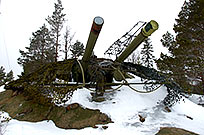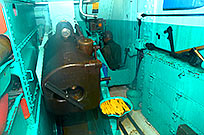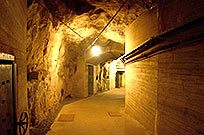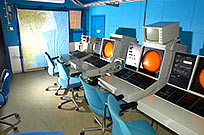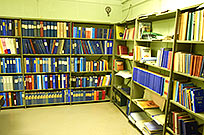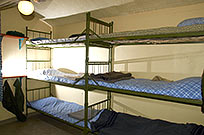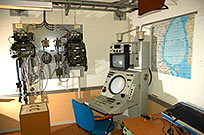Fortress Hemsö
At the mouth of the river of Ångermanälven Hemsön island is. There is one of the largest fortress of the Cold War surviving to our time - Fortress Hemsö. 140-meter-high granite mountain Storåberget in the center of the island is riddled with numerous passages and tunnels, studded with armored gun's turrets, dotted with observation posts, MG bunkers and radar installations.
This area has always played an important role in the Swedish defense. In 1809, during the Finnish War, Russian Navy has repeatedly attacked the coast, the city of Härnösand was burned, as well as many villages on the coast. However, the first permanent fortifications and artillery batteries appeared here only in 1916 during the 1st World War.
Because of big strategic value of the place, as well as the growing political situation, the Swedish government decided to build a fortress Hemsё in 1953. Construction lasted for 4 years and was surrounded by a veil of secrecy. However, this veil has been partly dispelled when, after the revelations in 1963 Soviet agent Colonel Stig Wennerström of Swedish Air Force, it was found out that he had handed over to the Soviet Union classified information, including plans for the Hemsö fortress.
In 1964 in the fortress of large-scale modernization was carried out in the Fortress in order to increase its resistance to nuclear and chemical weapons.
Three vast underground complexes: turret 15.2 sm Storråberget battery, turret 8.5 sm Havstoudd battery and command and fire posts Kläffsö now are available for visit here. Under thick layer of granite barracks, warehouses, machine rooms, powder magazines, staff rooms and much, much more are safely sheltered. The garrison of a several hundred man could live and fight independently here for 5 months.
In 1989 Hemsö fortress has been decommissioned and until 1992 served as the educational center of the Sweden School of coastal artillery. In 1992 most of the fortress installations were transferred to civil authorities, along with all fortress equipment in full completeness.
Currently, there are guided tours for interested visitors in the fortress installations, accompanied by amiable Swedish-Finnish-Norway-Danish-English-speaking guides. Russian-speaking guides are not present, but write to me, and we can think about it...
Impressions
It is impressive not so much by it's size and preservation of structures, but the fact that all this was given free to the use of civilians in full working order and completeness, including bed linen and the secret library, not to mention the armament, wiring, etc. Like most such museums in Sweden tis one also exists due to the fees of visitors and small grants, and of course - the selfless work of many volunteers.
The underground vaults are clean, dry and warm. Everything is neatly painted, metal parts are lubricated. To maintain the necessary low humidity here requires considerable effort.
Special experience was a spending the night in underground barracks on the Swedish soldiers bunk. The local museum have such service for those who like to plunge into the life of a soldier in the Cold War times. The beds in the barracks are comfortable with warm blanket. The modest soldier's dinner with a few bottles of beer adds some wartime feeling.
But most interesting was that the fortress at night was in full my disposal and I could get anywhere I want, without any restrictions...
Land forts and fortress:
Bip Castle Gatchina Ivangorod Izborsk Kexholm Kirillov Monastery Koporye Novgorod Pechorskiy Monastery Peter&Paul Fortress Porkhov Pskov Schlisselburg Staraya Ladoga Tikhvin Vyborg Hameenlinna Hamina Kastelholm Kymenlinna Lappaenranta Raseborg Castle Savonlinna Tavetti Turku Visby Fredrikstadt Fredriksten Hegra Fort Hoytorp Fort Arensburg Narva Tallinn Antipatris Caesarea Jerusalem Latrun Fort Masada
Sea forts and fortresses:
Alexander Fort Ino Fort Krasnaya Gorka Fort Kronstadt: Kotlin isl. Kronstadt: North Forts Kronstadt: South Forts Trongsund Hanko Svartholm Sveaborg Marstrand Siaro Fort Vaxholm Oscarsborg
Artillery batteries and individual guns:
Coastal Artillery Hemso Fort
Fortified areas and defensive lines:
Karelian Fortified Area (KaUR) KrUR Leningrad Mannerheim Line Nevsky Bridgehead VT Line Harparskog Line Salpa Line Gothland
Russian
S e a r c h All news

